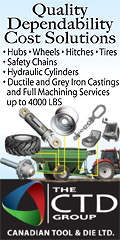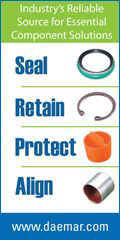AMC Connection
Agricultural Manufacturers of Canada
BOSVELD AND ASSOCIATES
ASSOCIATE MEMBER
ERIC BOSVELD - CONTACT
10 WRIGHT STREET
LONDON, ONTARIO N6M 1H6
CANADA
WWW.BOSVELDASSOC.COM
226-777-3078
WE ARE A GROWING NETWORK OF PROFESSIONALS IN THE AGRI-BUSINESS SECTOR THAT HELP OUR PRIVATE EQUITY AND AGRI-BUSINESS CLIENTS GROW THROUGH ACQUISITIONS AND THROUGH OPERATIONAL IMPROVEMENTS. WE HELP OUR CLIENTS EVALUATE AG BUSINESS INVESTMENT OPPORTUNITIES AND PROVIDE POST-ACQUISITION STRATEGIC ADVISORY SERVICES.
PRODUCTS & SERVICES:
- FINANCING PROGRAMS/SERVICES
RONCO FREIGHT INTERNATIONAL INC.
ASSOCIATE MEMBER
BRIAN WATSON - CONTACT
871 EQUESTRIAN COURT
UNITS 2-3
OAKVILLE, ONTARIO L6L 6L7
CANADA
WWW.RONFREIGHT.COM
905-847-5524
INTERNATIONAL FREIGHT FORWARDING AND LOGISTICS COMPANY PROVIDING GLOBAL TRANSPORTATION SOLUTIONS VIA OCEAN, AIR & GROUND TRANSPORTATION.
PRODUCTS & SERVICES:
- TRANSPORTATION LOGISTICS
- TRANSPORTATION SERVICES
FASTENAL CANADA
ASSOCIATE MEMBER
TREVOR NEWMAN - CONTACT
860 TRILLIUM DRIVE
KITCHENER, ONTARIO N2R 1K4
CANADA
WWW.FASTENAL.COM
519-897-2442
FASTENAL'S VISION IS SUMMED UP WITH FOUR WORDS: GROWTH THROUGH CUSTOMER SERVICE.
PRODUCTS & SERVICES:
- FASTENERS
COLUMBIA PLASTICS LTD.
ASSOCIATE MEMBER
RICHARD BOON - CONTACT
19320 60TH AVENUE
SURREY, BC V3S 8E5
CANADA
WWW.COLUMBIAPLASTICS.COM
604-530-9990
COLUMBIA PLASTICS IS A CUSTOM INJECTION MOLDING COMPANY OFFERING IN-HOUSE PART DESIGN, RAPID PROTOTYPING, TOOLING, MANUFACTURING I.E. OVER-MOLDING, DECORATING AND SUB &/OR FINAL ASSEMBLY.
PRODUCTS & SERVICES:
- PLASTIC MOULDING/MANUFACTURING
Brandt recently announced the appointment of nine new RDO Equipment locations in North Dakota, Minnesota, Washington and Oregon as authorized dealers for Brandt Agricultural Products.
"We are very excited that RDO Equipment is making such a strong commitment to Brandt by representing our company and products in nine more locations," said Dave Norheim, U.S. Sales Manager for Brandt. "RDO’s dedication to providing and supporting innovative solutions to agriculture customers is an excellent fit for Brandt."
Salford Farm Machinery Limited is adding two new parts distribution centers in western Canada, bringing the number of North American parts distribution locations to six, in order to help keep pace with the company’s expanding dealer network.
"We have seen rapid expansion of our dealer network in western Canada," said Jim Boak, Canadian sales manager at Salford. "As those dealers come on-line, we’re supporting them in a number of ways, including parts distribution to help keep their customers satisfied."
The new parts distribution centers are located in Manitoba and Alberta, close to major junctions on the Trans-Canada Highway to help maximize coverage and shorten delivery times. These two new locations complement existing parts distribution centers in Ohio, North Dakota, Iowa and Ontario.
"Together with these new distribution centers we’ve also added staff and made additional investments in our inventory management system, to better meet existing requirements as well as account for seasonal variability in our parts inventory," said Salford General Manager Geof Gray.
Gray says the new parts distribution centers will also benefit from and be supported by the company’s recently completed 54,000 square foot expansion at its Ontario facility. "The bigger shipping yard and increased warehousing space at our head office plant has helped us to hit the ground running at the two new distribution centers."
"AGCO’s strong performance in the first quarter produced record sales and earnings," said Martin Richenhagen, Chairman, President and Chief Executive Officer. "We capitalized on improved demand in key Western European markets and continued market strength in North America while executing against our important margin improvement initiatives. Margin expansion in the first quarter was led by the Europe/Africa/Middle East (EAME) and North American regions. EAME’s first quarter operating margins exceeded 11% and North American operating margins improved over 500 basis points compared to the first quarter of 2011. Our GSI acquisition was also a contributor to the positive results, particularly in North America."
Sales growth for the first quarter of 2012 was approximately 19.4%, excluding an 11.4% benefit of acquisitions and the 4.3% unfavorable impact of currency translation. AGCO’s EAME region reported a net sales increase of approximately 28.5% in the first quarter of 2012 compared to the first quarter of 2011, excluding unfavorable currency translation impacts. Sales growth was strongest in Western and Eastern Europe. In the North American region, sales in the first quarter of 2012 improved 58.6% compared to the first quarter of 2011, excluding unfavorable currency translation impacts. The GSI acquisition and growth in sales of sprayer equipment contributed to the results. AGCO’s South American region reported a sales increase of 7.0% in the first quarter of 2012, compared to the first quarter of 2011, excluding unfavorable currency translation impacts. The benefits of acquisitions drove most of the increase.
Sales growth and improved gross margins contributed to higher income from operations for the first quarter of 2012 compared to the first quarter of 2011. Production increases in Europe and North America, and a richer product mix, partially offset by higher material costs, produced improved gross margins. AGCO increased its investment in new product development, resulting in increased engineering expenses in the first quarter of 2012 compared to the same period last year.
The company expects global industry sales to grow modestly in 2012 compared to 2011. Growth is expected in Western and Eastern Europe and market conditions are projected to remain strong in North America and South America. Net sales are expected to range from $10.2 billion to $10.5 billion for the full year. Gross margin improvement is expected to be partially offset by increased engineering and market expansion expenditures.
Just 18 months after entering the precision seeding and tillage market, Versatile is introducing a new air drill with exciting new technology. The ML Series air drill will debut with the ML930 and ML950 models to enhance the lineup of Versatile precision seeding equipment.
Available in 3- and 5-section configurations from 40’ to 70’, the ML Series air drill features ALIVE technology: Accurate seed placement with Level, Independent openers for uncompromising Vertical Emergence of crops.
The ALIVE technology incorporates three critical features to achieve optimum seed and fertilizer placement. Independent shank technology, mechanical linkage and seed furrow selection.
Unlike traditional parallel link drills, the ML series does not rely on hydraulics to maintain a constant seeding depth, packing pressure or shank trip force. Frame height is adjustable up or down to increase or decrease packing pressure, which allows operators to pass through soft areas and over harder, knolls while maintaining consistent and precise seeding capabilities.
Versatile Director of Marketing Adam Reid, says, "Versatile entered the precision seeding and tillage market last year with products that are recognized for simplicity and efficiency. A team of engineers has been working on this new technology and we are extremely impressed with the results. The ML Series drill is able to maintain seeding depth, packing pressure and shank tip force without hydraulic cylinders on each shank, meaning that the tractor requirement, in both horsepower and hydraulic, is less than comparable existing parallel link drills. Combined with in-cab seed furrow selection, the ML Series drill is an exciting new piece of precision seeding technology."
Alamo’s 2012 results include the effect of the acquisition of Tenco, which was completed in October 2011. Tenco contributed $9.4 million to net sales in the first quarter of 2012 and $0.5 million to net income.
Net sales in the industrial division for the first quarter of 2012 were $64.7 million, a 32% increase compared to net sales of $49.0 million in the first quarter of 2011.
Alamo’s North American ag division recorded net sales of $48.3 million in the first quarter of 2012, a 3% decrease compared to net sales of $49.7 million in the prior year’s first quarter. The decrease reflected slower growth in the overall U.S. ag market and slightly lower preseason sales, which generally make up the majority of this division’s first quarter revenue.
The company’s European Division net sales in the first quarter of 2012 were $42.9 million, an increase of 2% versus $41.9 million in the first quarter of 2011.
Alamo and Alo also recently announced a major new manufacturing and distribution alliance for their tractor loader businesses in North America. Alo has been producing and marketing loaders and attachments under the Quicke brand in North America since 1989.
Loaders for the joint initiative will be manufactured in Alo facilities, including Telford, TN, a former Bush Hog plant acquired by Alo in 2009 prior to Bush Hog becoming a part of Alamo Group. Under the new alliance the sales organizations of Bush Hog and Rhino will be the representatives for Quicke brand loaders in the U.S. Consolidation of both production and sales activities is already underway and scheduled to be fully in place by July 1, 2012.
The Versatile RT490 combine is the first new combine introduced in North America in more than a decade and will further compliment the Versatile line of equipment. The threshing system on the Versatile RT490 is unique, featuring a rotating concave rotary system. A 360° concave counter rotates to the rotor for increased capacity, better productivity and reduced loss. This concave ensures that the entire thresher and separator area is utilized. A 4-stage feeder house with a unique inclined chamber replaces the traditional feeder housing with four feeding beaters, providing a considerable increase in processing stability and combine productivity by allowing a uniform layer of material to enter the rotor. The 340 bu. grain tank features standard hopper extensions that are controlled from the cab for transportation or storage.
Like all Versatile products, the new combine is powered by Cummins. The RT490 features a 490 horsepower Cummins QSX 11.9L engine that meets interim Tier 4 emissions standards.
Adam Reid, Versatile Director of Marketing, says this Class VIII combine has been thoroughly tested in a variety of crops and harvesting conditions, both in North America and around the world. "This combine has been through significant testing including more than 2000 acres in fields in Canada and the United States. Nearly every crop grown in North America has been tested including cereal crops, corn, pulse crops and rice. The productivity was excellent and the reliability of these combines was second to none."
Reid adds that the combine is a welcome addition to the Versatile product line, sharing the hallmarks of reliability, durability and ease of service and maintenance. "The RT490 is simple and convenient to operate and maintain.
Are you still filling out paper Records of Employment (ROEs)? Forget the paper! ROE Web is a secure and easy-to-use Web-based application that allows payroll administrators to create, submit, and amend ROEs online. ROE Web makes it easier for employers to fill out ROEs and simplifies the processing of workers’ Employment Insurance claims.
Use ROE Web to increase your productivity and reduce your paper burden and administrative costs. Visit our Web site or call the Employment Contact Centre at 1-800-367-5693 (TTY: 1-855-881-9874) for more information.
Service Canada – Relevés d’emploi électroniques
Remplissez-vous encore vos relevés d’emploi sur papier? Finissez-en avec la paperasse! Application en ligne conviviale et sécuritaire, RE Web permet aux administrateurs de la paie de créer, de transmettre, de modifier et d’imprimer des relevés d’emploi. RE Web facilite la tâche aux employeurs et simplifie le traitement des demandes de prestations d’assurance-emploi des travailleurs.
Augmentez votre productivité et réduisez la paperasserie et les coûts administratifs avec RE Web. Pour plus de renseignements, consultez notre site Web ou appelez le Centre de services aux employeurs au 1-800-367-5693 (ATS : 1-855-881-9874).
The 2012 Federal Budget introduces a number of changes to government participation in the Canadian marketplace. One of those includes support to Canadian manufacturing for investments in research and development through the Scientific Research and Experimental Development (SR & ED) Program. This article provides a consultant perspective on the analysis and public commentary that preceded the new Program formulation as defined by the 2012 Budget. While the program has changed in scope and design, the following comments serve to support the value of the SR & ED program and the contribution to it by industry consultants.
For those not familiar with the program, SR & ED has assisted Canadian businesses since 1986 in reducing risks associated with developing and improving technological processes, products, devices or materials. Under the SR & ED program both the Federal and the Provincial governments provide substantial cash credits to Canadian companies to assist them in recovering expenditures incurred during experimental and developmental projects. The intent is to stimulate companies to expand their knowledge, products and services. In 2010 (the latest estimates available), Canadian businesses received over 3.5 billion dollars in SR & ED credits from federal budget with provincial contributions adding funds on top of that.
More recently, the Harper Government appointed an independent panel to examine the costs and benefits of research and development support from Federal and Provincial governments over the past decade. The study made several criticisms of the Scientific Research and Experimental Development (SR & ED) program delivered by the Canada Revenue Agency (CRA) in partnership with various provincial jurisdictions.
This criticism was amplified by media pundits including Barrie McKenna of the Globe and Mail who bemoaned the cost of the program versus the demonstrated benefits. In particular, McKenna chose to conclude that most companies would undertake necessary innovation without government incentives. Further he suggested that the program created a "cottage industry of SRED Consultants" with the implied conclusion that they contribute little to the innovation process. Another review Panel chaired by Tom Jenkins from the software company Open Text took a more weighted approach. While supporting the concept of government incentive initiatives, his Panel offered recommendations for changes to the structure of current programs and reductions in the scope of SR & ED credits.
Given the importance of a competitive SME sector in our economy, one would hope that the current changes to SR & ED will capture the view point of all stakeholders before throwing out the proverbial baby with the bathwater. One particular and important perspective is the collective experience and lessons learned of the consulting sector. One can assume that with or without government innovation programs, a consultant sector will inevitably continue to provide expertise to companies in their dealings with government taxes.
MPG Consultants reflect a technical perspective with nearly a decade of experience with the SR & ED program in Eastern and Western Canada. Our clients come from a broad range of industries with the bulk of them being in manufacturing and machine building. In addition, the scope of our clients ranges from the small three to four employee ‘mom and pop’ operations through to corporations with over 150 employees. That experience leads us to a number of insights relative to the overall benefit of the program as well as to how clients can best benefit from the SR & ED program.
By any standards, our experience suggests a number of positive impacts of the research and development support offered through the CRA programs. On a day-to-day basis, we see the challenges faced by our clients in ensuring both the profitability and competitiveness of their individual operations. The recent government review has chosen to highlight a priority for supporting single-focus "breakthrough" technologies with more generous and less controlled targeted grants. We would not diminish the importance of breakthrough technologies. However, the government study and media analysis, unfortunately, all too often dismiss the importance of small incremental improvements to manufacturing and production process – such improvements reflect the ‘muscle and bone’ of SME successes in our country. Machine builders or anodizing plants rarely deliver break-through technologies. However, their very survival as businesses is dependent on intense searches and testing of effective solutions which they would not likely undertake without the SR & ED program. Such solutions do require risk and do require experimentation to ensure the success of manufacturing lines.
The impact of the SR & ED program is further enhanced when we consider its contribution to the survival of Canadian manufacturing in the international marketplace. The cannibalistic thought that we do not need all industries in Canada, let the unfit industries die out and focus on break-through avenues, is strategically dangerous. Let us not forget the fate of the rare earth industry which was centered in the United States twenty years ago. With the absolute demise of rare earth production in North America the electronics industry has been left at the mercy of Chinese suppliers for rare earth materials supply at prices several fold higher in an already recession-stressed economy.
The Jenkins’ panel report came out at a time of radical changes by CRA to the SR & ED claim review process. Over the last two years the technical report format was substantially streamlined to allow computer screening and keyword analysis. In the same period CRA hired a cohort of new technical auditors (by tradition, called Research and Technology Advisors (RTAs) which enabled increased frequency of site audits in some regions by up to 50%. During the audits, RTAs imposed increased demand for detailed engineering and financial documentation that would ensure rejection of claims that might have readily received approval in previous years. The rationale for greater stringency in the review process is quite direct and driven by the need for improved program effectiveness and program value for dollar. In the financial crisis of 2008-2009 SR & ED claims from industry increased by 30-40% with anecdotal experience suggesting that many businesses were managing to survive thanks only to the assistance of the SR & ED money. At the same time, the capacity of Federal Government resources was increasingly challenged by these new demands upon the SR & ED program.
The Jenkins’ panel report and anti-SR & ED media campaign evoked grim expectations about the future of the program and rather intense background discussions involving SR & ED consultants and big accounting firms in early 2012. The Federal Budget of March 29, 2012 confirmed continuation of the Program with some minor modifications. These changes mostly impact big businesses and include:
1. Removal of the capital allowance from the expenditure base (for capital expenditures incurred after 2014)
2. Reduction of the proxy used to calculate overhead costs from 65 percent to 55 percent (to be fully introduced as of January 1, 2014)
3. Reduction of contract payment eligibility to 80 percent of the payment (effective January 1, 2013)
4. Reduction in the general investment tax credit rate for big businesses from 20 percent to 15 percent (effective January 1, 2014).
The revised program still allows SME’s to earn substantial credits for salaries spent on experimentation – depending on the province estimated at 64% in Alberta, 69 % in Saskatchewan and 74 % in Manitoba.
The underlying conclusion from our experience and the new SR & ED Program is that Government remains committed to its support of research and development investments by industry. Moreover, it underscores the need by AMC members to appreciate the benefits of the Program and the value of ensuring obtaining full benefit of the SR & ED Program. In many cases, that process can be very profitably assisted by specialist consultants.
Some important lessons and pointers from the past and optimum benefits for companies claiming tax credits:
· SR & ED is for everyone – not just academic bench research. In fact, statistics show that experimental development claims where manufacturers present their work on improving mechanisms, devices and perfecting their manufacturing process constitute bulk of credits received by SME
· The Program requires special knowledge of CRA mandated rules, regulations and most important -practices.
· As with all tax program processes, the support service provided by consultants ensure optimum benefit to companies and/or defense before government agencies and adjudication entities (e.g. tax courts)
· Time spent by a innovation manager or floor manufacturing supervisor on government technical and financial submissions is time directly taken away from company problem solving and innovation
· Awareness of the SR&ED program is generally good – however, many companies are not completely familiar with the program and, more important, dismissive of it based on the popular misconception that it is simply is not worth the time
· As engineering professionals, our mandate is not only to report to CRA but to critically review, analyze and advise clients on the best courses of experimentation
· The very process of tracking innovation (e.g. time tracking) for SR & ED program which was developed over years is itself a benefit to overall administrative management of the client’s company
One of the more mundane aspects of running a company—whether the company is a farm or one that makes the tools to farm with—is filling out Records of Employment (ROEs) when employees leave.
Human Resources Manager Candice Brooks is responsible for payroll at Supreme International in Wetaskiwin, Alberta. Supreme International, a manufacturer of vertical feed processors, employs 80 people. The company doesn't have a high staff turnover but, for a variety of reasons, people do leave, some permanently and some temporarily. Brooks says they file an average of about six ROEs a year, which also covers apprenticeship leave.
Eight years ago, Supreme International decided to start filing electronic rather than paper ROEs and registered for ROE Web. Brooks found ROE Web relatively easy to use and noted a particular increase in accuracy and efficiency with the online application.
"I like the fact that ROE Web prompts you if there is an error," Brooks says. "It helps you fix it right away. Whereas with paper, you do it and send it in and, if there is an issue, they’re going to call to question it, or it’s just not going to go through."
"As an employer, if it’s someone going on apprenticeship or maternity, you don’t want to be delaying them at all," she adds. "And you’re getting the ROE in electronically, so they’re actually able to go home that day and submit their EI application—not waiting for their ROE to come in the mail."
Jane Klyn, office manager with Salford Farm Machinery, in Salford, Ontario, agrees.
"It’s faster," Klyn says. "You just hit the button, and it goes right to Service Canada."
Salford Farm Machinery has 130 employees, and Klyn issues about 20 ROEs a year. Having issued paper ROEs for 20 years, she found the electronic forms themselves quite familiar.
In 2010, Klyn Registered Salford Farm Machinery with ROE Web. She says that a Service Canada representative came to her office and went through the process with her, step by step.
"We signed some paperwork, and from there it was a go," she says.
Both Klyn and Brooks use a payroll program that produces the ROE information, which can be simply uploaded to complete the ROE form. They don’t have to manually enter the information.
"I just upload and go. I don’t actually have to type up anything from scratch," says Brooks.
As a result, Brooks says the top benefit of using ROE Web is its accuracy and efficiency. She cites an employee going on an apprenticeship leave as an excellent example.
"If someone is going on apprenticeship leave, I’m able to process it [the ROE] the last day they are here and give it to them," she says. "They are able to process it immediately. So less wait time for them."
Klyn agrees. "We would not go back to paper filing," she says.
For her, the paper and mailing-cost savings and the reduced number of calls from Service Canada are the biggest benefits. With ROE Web, employers are no longer required to print a copy of the ROE for the employee or mail a copy to Service Canada.
"But I still keep a paper copy for my files—I’m a visual person," Klyn says.
However, for companies that issue a large number of ROEs, not having to print and store copies of the forms on site is a huge benefit. ROES can be backed up and saved on a computer or external hard drive. As well, Service Canada keeps a copy on its system, which employers can always access to make amendments, if required.
When asked what she would say to employers who are not yet using ROE Web, Brooks says: "Why aren’t they?"
For Brooks and Klyn, ROE Web’s accuracy and efficiency means not going back to paper forms.





